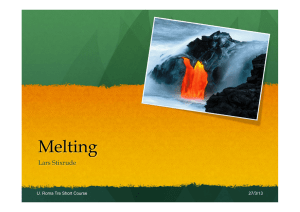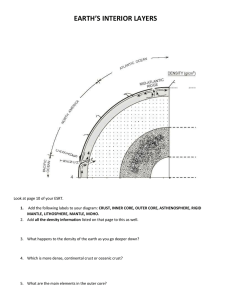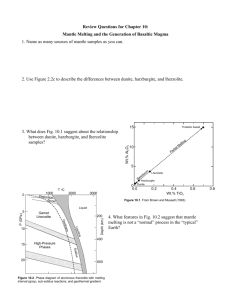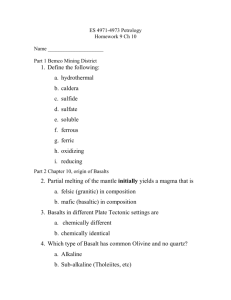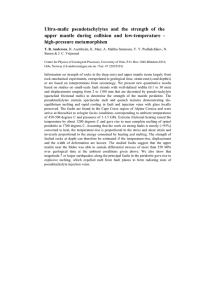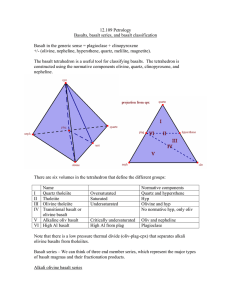12.109 Lecture Notes October 25, 2005 Handout: basalts
advertisement
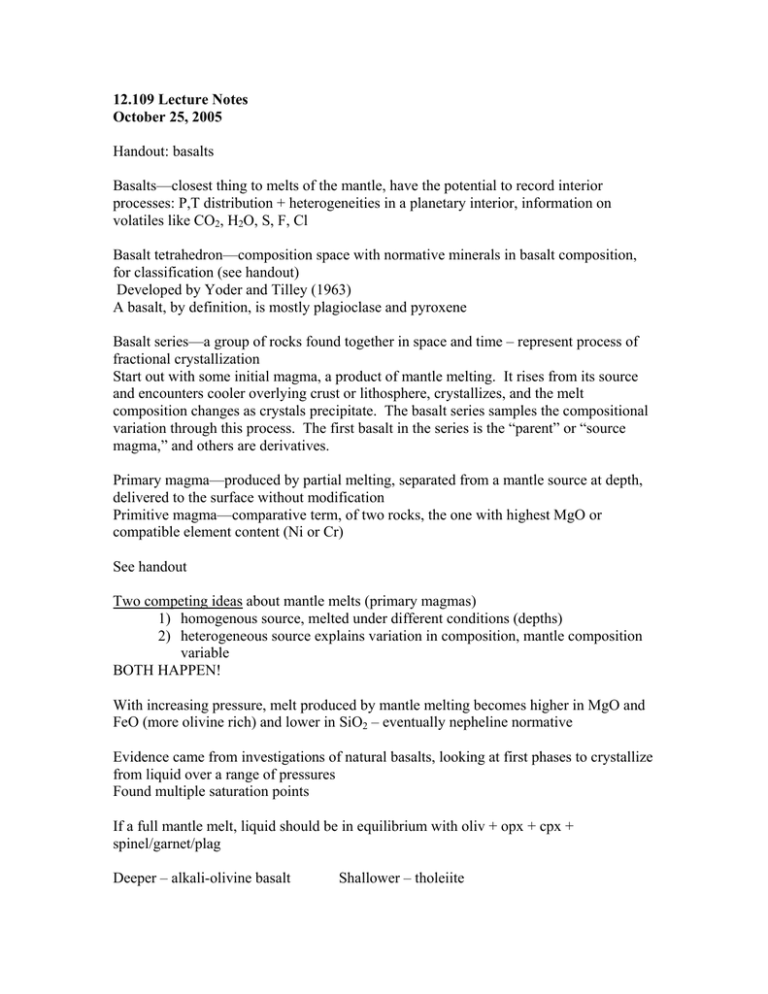
12.109 Lecture Notes October 25, 2005 Handout: basalts Basalts—closest thing to melts of the mantle, have the potential to record interior processes: P,T distribution + heterogeneities in a planetary interior, information on volatiles like CO2, H2O, S, F, Cl Basalt tetrahedron—composition space with normative minerals in basalt composition, for classification (see handout) Developed by Yoder and Tilley (1963) A basalt, by definition, is mostly plagioclase and pyroxene Basalt series—a group of rocks found together in space and time – represent process of fractional crystallization Start out with some initial magma, a product of mantle melting. It rises from its source and encounters cooler overlying crust or lithosphere, crystallizes, and the melt composition changes as crystals precipitate. The basalt series samples the compositional variation through this process. The first basalt in the series is the “parent” or “source magma,” and others are derivatives. Primary magma—produced by partial melting, separated from a mantle source at depth, delivered to the surface without modification Primitive magma—comparative term, of two rocks, the one with highest MgO or compatible element content (Ni or Cr) See handout Two competing ideas about mantle melts (primary magmas) 1) homogenous source, melted under different conditions (depths) 2) heterogeneous source explains variation in composition, mantle composition variable BOTH HAPPEN! With increasing pressure, melt produced by mantle melting becomes higher in MgO and FeO (more olivine rich) and lower in SiO2 – eventually nepheline normative Evidence came from investigations of natural basalts, looking at first phases to crystallize from liquid over a range of pressures Found multiple saturation points If a full mantle melt, liquid should be in equilibrium with oliv + opx + cpx + spinel/garnet/plag Deeper – alkali-olivine basalt Shallower – tholeiite How do you melt the mantle to produce basalts? We’ll use mid-ocean ridge basalts (MORBs) as an example because this is a part of the earth where processes of melting are well-understood. MORBs are usually olivine tholeiites. Melting processes at MORs occur to a shallow mantle depth, approximately 10 km. In 1864, Lord Kelvin wrote about adiabatic decompression melting, where superheating from decompression provides the thermal energy for melting. At MORs, melting records variation in mantle potential temperatures. EXAMPLE: Suppose we cool the mantle 50ºC. The specific heat is about .25 cal/gram/degree and the heat of fusion is about 100 cal/gram. 50ºC * .25 cal/gram/degree = 12.5 cal/gram to put into melting the mantle Æ 12.5% of the rock melts. A higher mantle potential temperature means melting starts earlier and at greater depths. This is revealed by the basalt composition, particularly by looking at the percentages of Na and Fe in the basalt. Na is one of the first components to melt, so a basalt with a high Na/Fe ratio came from a rock melted to a lower degree, lower percentage melted out, and so had a lower Tp, than one with a low Na/Fe ratio. Graph of global Na 8.0 vs. Fe 8.0 trend – Klein and Langmuir, 1987 Water depth can be proxy for mantle potential temperature. Low FeO and high MgO signifies great water depth and mantle potential. High FeO and low MgO usually means that the water depth is shallow. There is also a trend with ocean crust thickness: the density of basalt magma is 2700 kg/m3, and that of peridotite is 3300 kg/m3. When the melt is removed, the density of the peridotite goes down. A less buoyant mantle will lead to a thinner ocean crust.
